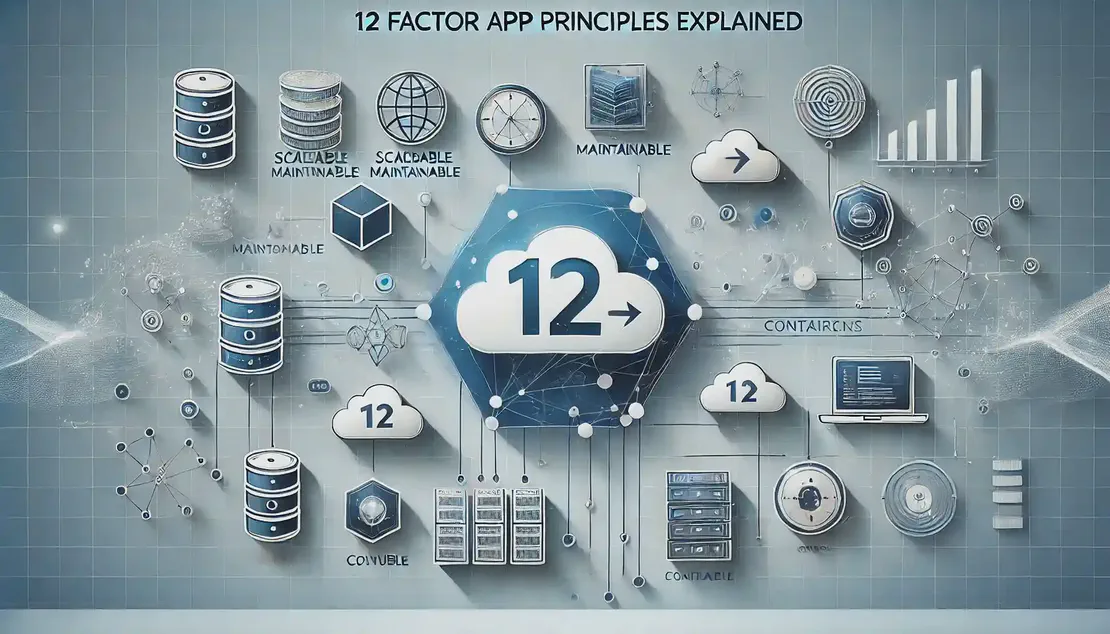
12 Factor App Principles Explained
- Vipul Kumar
- 12 factor app , Cloud native , Software best practices , Scalability
- December 20, 2024
Table of Contents
📜 Codebase — Maintain a single codebase tracked in version control, with multiple deployments. This ensures consistency across environments and simplifies the management of different application versions.
🔗 Dependencies — Explicitly declare and isolate dependencies to avoid relying on system-wide packages. This practice ensures that the application can run consistently across different environments.
⚙️ Config — Store configuration in the environment, separating it from the codebase. This allows for different configurations in development, testing, and production without altering the code.
🔌 Backing Services — Treat backing services like databases and message brokers as attached resources. This approach promotes flexibility and portability, allowing services to be easily swapped or moved.
🏗️ Build, Release, Run — Separate the build, release, and run stages to ensure a clear and repeatable deployment process. This separation helps in maintaining a stable and predictable deployment pipeline.
🌀 Processes — Execute the app as one or more stateless processes, which facilitates scaling and resilience. Stateless processes can be easily replicated or replaced without affecting the application’s state.
🔊 Port Binding — Export services via port binding, making the application self-contained and independent of external web servers.
📈 Concurrency — Scale out via the process model, allowing the application to handle increased load by running multiple instances of processes.
🚀 Disposability — Maximize robustness with fast startup and graceful shutdown, ensuring that the application can quickly recover from failures.
🔄 Dev/Prod Parity — Keep development, staging, and production environments as similar as possible to reduce the risk of unexpected issues during deployment.
📜 Logs — Treat logs as event streams, allowing them to be aggregated and analyzed separately from the application.
🛠️ Admin Processes — Run admin and management tasks as one-off processes, ensuring they are consistent with the application’s codebase and environment.
History and Origin
📅 Origin — The 12 Factor App methodology was developed by Heroku developers, including Adam Wiggins, around 2011. It was designed to improve the development and deployment of software-as-a-service applications.
🏢 Heroku — A platform-as-a-service company that played a significant role in popularizing the 12 Factor App principles, which are now widely used in cloud-native application development.
📜 Purpose — The methodology aims to create applications that are portable, scalable, and maintainable, aligning with modern software development practices.
🔄 Evolution — Over time, the principles have been adapted and integrated into various software development frameworks and practices, especially in the context of microservices.
🌐 Influence — The 12 Factor App principles have influenced the design and architecture of many cloud-based applications, promoting best practices in software development.
Application in Microservices
🔍 Microservices — The 12 Factor App principles align well with microservices architecture, promoting independent and scalable services.
🔗 Codebase — Each microservice should have its own codebase, facilitating independent development and deployment.
🔄 Dependencies — Microservices benefit from explicit dependency management, ensuring consistent environments across services.
🌐 Portability — Treating backing services as attached resources enhances the portability and flexibility of microservices.
📈 Scalability — Stateless processes and concurrency principles support the horizontal scaling of microservices, allowing them to handle varying loads efficiently.
Benefits and Criticisms
👍 Benefits — The 12 Factor App principles promote best practices in software development, such as scalability, portability, and maintainability.
🚀 Agility — By minimizing divergence between development and production, the principles support continuous deployment and rapid iteration.
🔄 Flexibility — Treating backing services as attached resources allows for easy swapping and integration of new services.
📉 Criticisms — Some developers argue that the principles may not be suitable for all types of applications, particularly those with complex state management needs.
🔍 Adaptation — While the principles are widely adopted, they are often adapted to fit specific project requirements and technological contexts.
Read On LinkedIn | WhatsApp | DEV TO | Medium
Follow me on: LinkedIn | WhatsApp | Medium | Dev.to | Github
The Twelve-Factor App
12factor.net
12 Factor App Principles and Cloud-Native Microservices
medium.com
Twelve-Factor App methodology
en.wikipedia.org
An illustrated guide to 12 Factor Apps
redhat.com
What is Twelve-Factor App?
geeksforgeeks.org
Using the 12-Factor Approach for Microservices
blog.clearscale.com
12 Factor Methodology: A Beginner's Guide
divio.com
The 12-Factor App Methodology Explained
netsolutions.com
Twelve-Factor Methodology in a Spring Boot Microservice
baeldung.com
